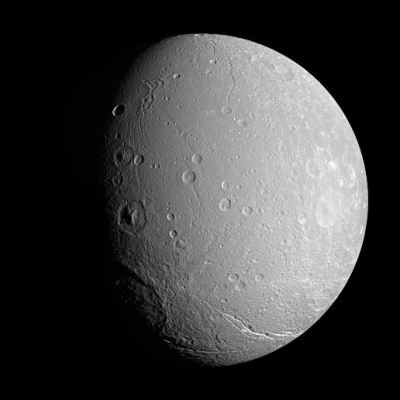20 June 2007

Credit: NASA/JPL/Space Science Institute
NASA recently published an exquisite image of Saturn's intriguing moon Dione, acquired by the Saturn-bound Cassini spacecraft. The image shows in crisp detail the craters and deep valleys on Dione's surface.
The sharpness of the image enables scientists to study the craters of Dione (1,126 km across). The number of craters provides valuable information about the geologic evolution of a planetary surface. Densely craters regions are believed to be old surfaces, while areas with fewer numbers of craters are likely to be young or geologically active.
The above image shows the remarkable variations in the density of impact craters on the surface of Dione. More craters are visible on the right side of this image than on the left. The southern end of the bright Palatine Linea fracture system is observed near the bottom. Part of a large impact basin can be seen at lower left, along the terminator, the line between the dayside and nightside on Dione.
The image is a mosaic of monochrome images, taken with Cassini's narrow-angle camera on 24 April 2007. The spacecraft was approximately 121,000 km from Dione. Image scale is 723 meters per pixel.
This mosaic is an orthographic projection centered at 33° South, 74° West, over the southern part of Dione's leading hemisphere. An orthographic view is very similar to the view seen by a distant observer looking through a telescope. The monochrome images were taken in spectral filters sensitive to wavelengths of light centered at 338, 568 and 930 nanometers.
Through Cassini's data, scientists recently made the exciting discovery of possible signs of geologic activity on Dione.
Further Reading
Cassini-Huygens Mission
http://saturn.jpl.nasa.gov/home/index.cfm
Cassini Finds Saturn's Moons Are Active
http://www.jpl.nasa.gov/news/news.cfm?release=2007-065
Aymen Mohamed Ibrahem
Senior Astronomy Specialist